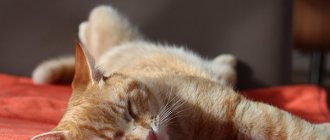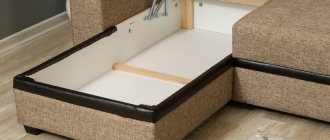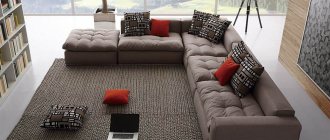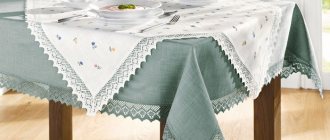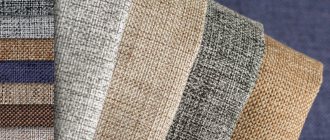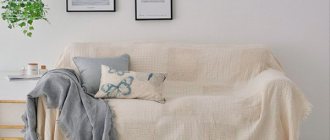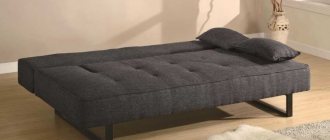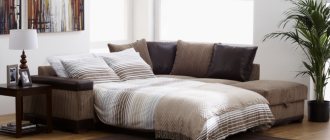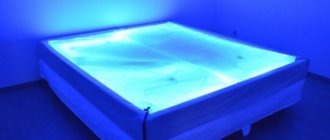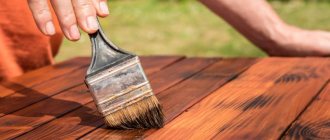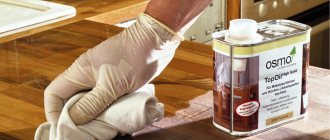The veil is part tradition and part necessity. With the help of covers, people try to maintain the appearance of furniture, and at the same time increase comfort. In the same way, they add color and light to the atmosphere, and arrange the room in the spirit of English or country style. The technology of sewing bedspreads is passed on by craftsmen from generation to generation, just like the designs on them. This is their special value. It is understood mainly by those who are somehow familiar with the manufacture of textiles. Covers protect sofas from pets and restless children, from scratches and stains. But for housewives, this is, first of all, an interesting process and an opportunity to make something big and valuable with your own hands. Colorful bedspreads on corner sofas, beds, and armchairs are a subtle design technique that requires good taste. Capes are used to cover furniture in living rooms, bedrooms and other living spaces.
Advantages and disadvantages of using bedspreads and covers
They protect furniture from dirt, give it a neater look and quickly hide clutter. These are just the direct benefits. Among other advantages, it is worth emphasizing the wide range of prices, variety of sizes of both factory-made and home-made products. Bedspreads and covers are usually wear-resistant, and caring for them takes about an hour a month. It is enough to clean it from dust once a week and wash it once a month. Bedspreads and covers keep their shape well and hide uneven furniture, as well as other imperfections. Capes can be created in any color scheme, and their material can be selected from natural raw materials.
Obvious disadvantages are poor compatibility with modern interiors and the high price of truly exclusive and high-quality options. It is worth noting that although stains “go away” from bedspreads relatively easily, thick and saturated liquids leave permanent marks.
Beautiful examples in the interior
Having become familiar with the varieties of bedspreads for sofas, you should consider several original options for decorating upholstered furniture.
This type of yarn is characterized by a soft texture, tenderness to the touch, and warmth on winter evenings. No wonder lovers of romance spend their evenings in front of the fireplace, wrapped in such blankets. The reverse side has a smooth and silky lining. The color scheme of the blanket is presented in a variant that contrasts with the sofa.
The sophistication and sophistication of a microfiber cape is visible to the naked eye. The softness and delicacy of the texture appeals to both children and adults. The monotony of the color goes well with the light palette of the sofa.
A sofa cover made of natural fur looks luxurious, rich and elegant. The visible softness of the pile complements the color of any interior. A fur cape looks especially laconic on top of upholstered furniture in the winter.
The color scheme in this case fits perfectly with the interior of light shades.
Tapestry knitted capes
In the past, tapestry covers for sofas, armchairs, and ottomans served as decor for upholstered furniture and were considered luxury and wealth. Tapestry capes were specially sewn to order from expensive threads; a lot of time was spent creating unusually beautiful patterns by which one could recognize the hand of the master.
But tapestry bedspreads have not lost their sophistication and beauty in the interior. Moreover, harmonious shades and patterns will emphasize your refined, subtle taste.
The tapestry is created using sophisticated technologies developed by the ancient Egyptians. Modern tapestry production is very different from ancient Egyptian production. It all starts with a sketch. You can transfer any drawing, landscape, or still life to the future canvas.
There are approximately 300 shades in the tapestry palette, while the threads used to create the canvas come in only five colors. When we deal with paints, we can easily get any shade just by mixing colors. In the invention of shades, threads are mixed on the canvas to create new shades.
Quilted bedspreads
The sophisticated color scheme will lift your spirits and please the eye. The advantages include the fact that they have a sealant inserted between the main material and the lining fabric, most often a padding polyester.
There are these types of stitches:
- thread stitching - expensive models;
- thermal stitch.
Thermal stitching is used only for bedspreads made of artificial fabrics. It involves bonding the layers of a bedspread using a special device that precisely melts synthetic fibers.
It is voluminous and takes up a lot of storage space. Therefore, it is difficult to wash. Any bedspread must be washed at least 2 times a year. Or clean it from dust and be sure to ventilate it.
Choosing fabric for the bedspread
Material that is pleasant to the touch will do. Cotton is a classic. There is no point in describing all its advantages. Suffice it to say that it is lightweight, durable and breathable. Velvet, artificial and natural velor are suitable. Some people prefer synthetic fur. Anyone who knows how to work with this fabric will be pleased with the result. It is easy to wash and clean, but only with a limited set of products. The best protection against external influences on the bedspread itself and the sofa will be a microfiber cape. In addition, it holds its shape well. A prestigious option for any application is silk. The cost of expensive covers made from this material reaches the price of a simple corner sofa. A room in a youth or vintage style will be decorated with a jeans cover. You need to select a proportionate piece of fabric depending on the purpose: cover the entire corner sofa with one piece or two.
Tapestry fabric has equally good strength and decorative properties.
Necessary equipment
The set of tools depends on the design of the product and the type of fabric. The standard set of sewing accessories will be the following tools:
- Scissors or textile knife.
- Chalk, measuring tape.
- Awl, thread, needle, safety pins.
- An elastic band, tape or lace to secure some parts.
- Sewing machine for forming basic seams.
- Iron for smoothing seams.
You may be interested in: Patterns and sewing of children's and women's sandboxes (rompers)
Tools Depending on the model and special manufacturing conditions, other tools and devices may be used.
How to take measurements correctly
The corner sofa is mentally divided into rectangles. The backs, seats and armrests are measured, after which the results are summed up and the parameters needed for sewing are obtained. When ordering, you should ask for a larger quantity in order to have both stock and room for error. For beginners, taking measurements will be difficult, because in addition to the 3 main parts, you also need to get small ones. To avoid mistakes, you should use paper: draw a model of a corner sofa on it in detail. Or, print out a photo and put numbers on it. You should remember the need to maintain a pattern, be it stripes or images. Otherwise, the product will turn out unattractive. Any pattern will increase the fabric consumption by almost 2 times. Beginners may need to discard any patterns or prints on the material. In this case, you will still need to maintain a margin around the edges.
Calculation of the required amount of fabric
Add 1-1.5 cm to all sizes. If suddenly they turn out to be superfluous, then the benefit will be all the same - they are used to correct worn parts of the bedspread. After meticulous measurements of each detail, the indicators are transferred to graph paper, maintaining the cutting directions and choosing the optimal scale. All parameters are then displayed on the fabric: the fabric is placed on a smooth surface with the wrong side up. Markings are made with a bar of soap or chalk. Allowances of 0.7-1.5 cm are left for seams, hems, etc. The amount of fabric and its calculation for corner models is very different. In any case, it’s worth taking a reserve and adjusting these allowances during the fitting. It often happens that the deviation towards increase is too large. Then it is simply removed with scissors. The higher the accuracy required, the wider the allowances are made.
Shape and cut of the bedspread
The shapes of sofas tend to be rectangular or square, but they look like that only at first glance. Calculating the ideal proportions of a cape is almost impossible due to the fact that even in the production facilities themselves there are no exact templates for this type of furniture. Each sofa is upholstered individually. Thus, for a blanket on a corner sofa, it is important that it does not sit flush on the furniture. It's better to let it drive than to look like upholstery.
The pattern pieces come in approximately 5 different shapes. The front parts of the backrests correspond to rectangles with the lower side cut off. The lower parts and seats are made of one piece. The shape of the main parts of the armrests vaguely resembles a glove, only with smooth edges. The front parts of the armrests have the appearance of a candle. The back elements of the backrest are a narrow rectangle with one rounded corner. This is what the set of components looks like.
It’s not scary if the patterns don’t work out the first time - in the future you need to draw and cut more slowly, and the help of computer modeling programs won’t hurt either!
Stage 2: Landscaping
- Place the pallets in place to see what the terrace will look like.
- Rearranges pallets to obtain the required shape and fit them together.
- When you find a pallet installation scheme that suits you
- Make a mark on the ground along the outer edge of the pallets. We used a shovel that we stuck into the turf.
- remember the location of each pallet, you can number them. We took pictures to remember.
- Remove the pallets and remove all turf from the marked area.
- Using a shovel, rake and maybe a hoe, level the surface and compact it. Use the level to control.
- Laying out the pallets
- We lay out the pallets one by one, carefully leveling them in height
- we twist the pallets together
- It's better to do this with an assistant
- We use a grinding wheel to clean the resulting surface. To check, you can walk barefoot, of course, if you are sure that you have cleaned everything thoroughly and will not get a splinter
Method of fastening the bedspread
Due to the structural complexity of the corner sofa, they resort to additional fastenings for the fabric. The product will not slide on the upholstery or fall off the sofa if you use one of the following options:
- lacing;
- buttons;
- buttons;
- Velcro tapes;
- rubber bands.
Laces are used as a hidden fastening or as a decorative element. If you choose this option, then only with loops, otherwise, after the end gets into the textile tunnel, you will have to spend a lot of time and effort to get it back. And this is the best case scenario. Buttons are a tried and true classic. They have a simple operating principle and a long service life. Buttons are replaced quickly and easily. The buttons often come off, but they hold the cape in place very tightly. Plastic options fail less often. Velcro tape is a great anti-slip option. Retains its properties for several years. An elastic band is considered the best method of fastening, because then the bedspread can be quickly removed and put on without much effort.
Where to find it
There are several ways to purchase such a decorative product.
Many different products can be found in stores or online. Among the huge number of options, you can choose exactly the one you like. You can also find out from a consultant how to care for the product you have chosen. And in a short time your sofa will shine with new colors.
If you know how to sew or knit and know a lot about fabrics, then you can make a blanket with your own hands. But it is worth remembering that even if you have a good sewing machine, basic and finishing materials and a lot of imagination, it will take a lot of time to make such a product. If you have extra time, then a handmade blanket will add warmth and comfort. In addition, you will be able to show your friends and family what a craftsman you are.
You can also order a sofa cover from the studio. The big disadvantage may be the fact that you will have to make a choice based only on the available materials. It is unknown whether the fabric will be in the right color and texture. Moreover, all the work will depend on the studio workers and the designer, and it will take a lot of time.
Bedspread style and decor
The decorative aspect includes 4 nuances. Firstly, this is the volume of the product. It is attached using a simple foam pad on the wrong side. Then it will be more comfortable to sit. The second point is the density of the pattern. A dense workpiece is stitched twice and with thick threads. The appearance of the product is also improved with bows and ribbons. Additional decor is usually pillows and cushions.
Styles for decorating bedspreads:
- Oriental;
- English;
- loft;
- country;
- patchwork.
To convey Eastern culture, many ornaments are used, while avoiding images of animals and people. A cape is suitable for an interior that needs emphasized status. The laconic and elegant English style brings together the best of what has become a classic. A brown cape with a regular white pattern will be just right. The loft setting is emphasized with a thick monotonous product or a tapestry cape. For the country style, simple home models with a slight carelessness in execution will do. For the sake of patchwork style, it is not necessary to sew a bedspread from scraps; you can simply choose the appropriate color.
Cape colors
There are a huge variety of color solutions for this textile, for example, products can be green, light green, turquoise, orange, yellow, burgundy, blue, black, violet, beige, blue, gray, white, or even have a two-color design with a combination of different colors.
It is not advisable for the blanket to have a shade that is not repeated in the surrounding interior space or matches the color of the upholstered furniture; this will deprive the blanket of its individuality.
Capes in more neutral and discreet colors with soft textures do not create bright accents and create a calm and peaceful design.
Master class on sewing bedspreads for a corner sofa
Making a bedspread for a sofa involves simple steps, but the difficulty is not to miss anything and to follow the step-by-step algorithm. First, we inspect the furniture: we study its shape, dimensions, individual elements and their parameters. From this information we can imagine how much fabric will be needed. At the same time, we decide on the material. This stage is difficult in the sense that you immediately need to decide whether the design/pattern will be on the cape or not. If yes, additional amount of matter will be needed. On special paper, we first draw the edges, and then cut out patterns (patterns) to replicate the constituent elements of the sofa. At this point, look at the scaled drawing and check the shape and size. Then we transfer the parameters to the fabric. We process the material for the bedspread, and after that we can move on to stitching the parts. We finish the almost finished cape with fittings and decorate it.
Making your own sketch and pattern
First of all, we study the dimensions of the furniture. We measure the sofa from the floor to the top, as well as along the floor covering. We sum up all the distances and multiply by 2 in order to approximately know the required length of the fabric, or rather, its minimum. Counting will give you an idea of the size of the patterns. Then we take white material, for example, tracing paper, and place it on the corner sofa. To make sure that its dimensions are sufficient to accommodate the contours. In the future, we will roughly understand the required dimensions for the fabric itself. Already at this time, you can draw a sketch on plain paper with all the sizes and exact proportions of the elements. So, we remove the tracing paper and transfer the size and shape parameters from the sketch. We do everything by hand, so we use a ruler. A few broken patterns are not a problem. We cut out the necessary shapes, sign them and number the same ones.
How to correctly transfer a pattern to fabric
The transfer includes 6 stages. First, we place the pattern on the fabric in one way or another, and smooth the material itself. The sample is then secured with fixing weights. We transfer its edges to the fabric. We use disappearing tailor's chalk. Then we move on to cutting the fabric, and when the stage is completed, we transfer the control marks to the material. We duplicate the contours on paired and symmetrical parts.
During the process, the craftsmen use carbon paper. In order to achieve perfect symmetry of identical parts. It is placed under the fabric, exactly under the place where the pattern is located. A wheel with a smooth or jagged edge is used to move along the fabric in places where there are allowances and borders. This is how the lines are pushed. The coloring pigment leaves a mark on the fabric - a shape that perfectly follows the outline of the pattern. Craftsmen protect the bedspread material from paint and dents using simple solutions:
- Cardboard placed under the wheels.
- Folding the fabric in half, facing inward, so that the dye remains on the inner surface.
Sewing and finishing of edges
You will need a sewing machine, pins, a tailor's yardstick, scissors, and thread. So, we fold the patterns face inward and baste them with temporary stitches. We try on the received parts on the sofa. If the result is acceptable, then we begin to sew the seams. We bend all the edges and sew them together again. Check the evenness of the bottom. After this we sew the product. It is difficult to guess the time costs. If the cover is designed to cover the entire sofa, including the backrest, then it will actually be three-dimensional. Because of this structure of the bedspread, the material has to be moved under the needle. We try on the pre-finished product on the sofa again. If it is not pressed too hard, then everything goes as it should. We connect all the remaining edges and move on to design and decor. We install fasteners or ties in pre-designated places. Then we decorate the cape with ribbons, pockets or other elements.
Features of sewing leather cases
The material for the leather case is not swept away or pinned; instead, clips are used. A special foot and needle are used and sewn with medium or large stitches. Universal threads of medium thickness made of synthetic material are suitable for this work. For beginners, it is better to take especially durable ones. Beginners should also not choose a skein with a color that contrasts with the skin, but only in one tone. The skin is fastened with clamps aligning the recesses and corners. In difficult moments, when the edge of the cover is being sewn off and a couple of layers need to be stitched, the movements are made as slowly and carefully as possible. The sharp end of the needle is moistened with baby oil. It is applied to the instrument with a cotton swab. As for the stitch size, an interval of 4.5-5 mm is used for stitching, and 3-3.5 mm for stitching. In areas of the leather case that are not visible from view, several small holes are made to improve air circulation.
DIY sofa blanket made from old jeans
You should choose unwanted jeans, but use only those areas of clothing that are well preserved and practically not frayed. The finished craft will have an attractive appearance if the thickness and density of the fabrics from different trousers are approximately the same. The color may vary. For sewing, choose one of four techniques:
- Quick squares;
- Watercolor;
- By stripes.
The first technique will be suitable for beginners. The principle is to use two types of denim to create the first shape from two rectangles. Then they take a rectangle of the third fabric and sew it with the long side to the narrow part of the finished element, which completely matches in size. This is how several sleeves are made, which are then combined into compositions. The watercolor technique means combining pieces into a thoughtful sequence of colors. The strip method means a loose arrangement of long fabric pieces.
Decorating a blanket
To create an extraordinary thing with your own hands that will not only look charming, but also to knit the fabric in an original way is not enough. You also need to decorate the edges beautifully. For this you can use:
- Lace border, various configurations. It can go in a straight line, be composed of various elements in the form of flowers, butterflies and leaves, and also have an uneven edge (teeth, semicircles, steps).
- Fringe, bells or pompoms.
- For knitting products, you can use a knitted pattern along the edge.
How to care for covers and bedspreads
Bedspreads and covers are washed approximately once a month - this is all basic care. Usually the manual option is chosen. Contamination is removed with a stain remover: separately and as quickly as possible. They also use machine wash at a water temperature of no higher than 30 °C and on a delicate cycle, regardless of the material. The bedspreads can withstand dry cleaning. Once a week, all dust is removed from them, and periodically they are combed with a brush to straighten the fibers, eliminate parasites and remove small particles of dirt and food. Thick capes are aired at least 2 times a year. They are taken out into the dryer, onto the balcony or street. The permissible ironing temperature is limited to 100 degrees, both with and without steam. To prevent foreign odors from emanating from the bedspread, it should be stored in a ventilated room on relatively free shelves.
Fashion trends
Immerse yourself in fashion trends through color. There is nothing accidental in fashion; serious institutions are working on a new palette. Including the American company Pantone. At the end of each year, she announces the fashionable shades of the next year, and they soon appear on the catwalks and in interiors.
The colors of 2022 are calm gray Ultimate Gray and lemon yellow Illuminating, which combine to create a calming and at the same time optimistic palette. This is the first time Pantone has chosen not one, but two colors.
Gray color of 2021 symbolizes thoughtfulness, yellow shade - optimism and the promise of a sunny day
